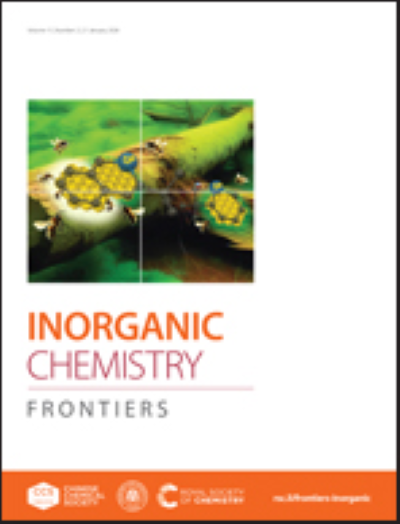Enhanced Electrocatalytic Hydrogen Evolution with Bimetallic Ru/Pt Nanoparticles Supported on Nitrogen-Doped Reduced Graphene Oxide
IF 6.1
1区 化学
Q1 CHEMISTRY, INORGANIC & NUCLEAR
引用次数: 0
Abstract
The electrocatalytic hydrogen evolution reaction (HER) has been explored using mono- and bimetallic Pt-Ru nanoparticles (NPs) deposited onto nitrogen-doped reduced graphene oxide (NH2-rGO) in acidic media. In this contribution, monometallic and bimetallic nanoparticles with three different Pt/Ru ratios (1/5, 1/1, and 5/1) have been used, yielding five different materials denoted as PtxRuy@NH2-rGO (x = 0, y = 1; x = 1, y = 0; x = 1, y = 5; x = 1, y = 1; x = 5, y = 1). The materials were characterized using a variety of state-of-the-art techniques, including high-angle annular dark field scanning transmission electron microscopy (HAADF-STEM), energy dispersive X-Ray spectroscopy (EDX) and X-Ray absorption spectroscopy (XAS), enabling the investigation of differences in morphology, coordination environment and oxidation state as a function of the metal composition of the graphene-supported NPs. The materials exhibited HER activity and demonstrated competitive overpotentials close to the thermodynamic limit. The initial catalytic activity of the as-synthesized materials enhances as the Pt/Ru ratio increases. Chronopotentiometry cathodic experiments showed that under reductive conditions the electrocatalytic performance is drastically impacted. Ru-rich materials were activated, whereas Pt-rich materials showed poor stability. Upon applying a reducing potential for 58 h, Pt1Ru5@NH2-rGO reached the best catalytic activity with outstanding overpotentials of h0 = 0 mV and h10 = 3 mV and no signs of deactivation even after 12 additional hours of electrolysis. According to DFT calculations, all nanoparticles present surface sites whose hydrogen adsorption energy is optimal for HER. In agreement with the experimental data, the Pt1Ru5 model shows the highest number of highly active sites, especially those involving Ru centres close to the Pt-Ru interface. Combining thorough characterization and computational modelling, this work reveals that the synergy between the two metals, structural features, and their affinity for the support are responsible for the observed differences in catalytic activities and stabilities.氮掺杂还原氧化石墨烯负载双金属Ru/Pt纳米颗粒增强电催化析氢
在酸性介质中,利用单金属和双金属Pt-Ru纳米颗粒(NPs)沉积在氮掺杂的还原氧化石墨烯(NH2-rGO)上,探索了电催化析氢反应(HER)。在这项贡献中,使用了三种不同Pt/Ru比率(1/ 5,1 /1和5/1)的单金属和双金属纳米颗粒,产生了五种不同的材料,表示为PtxRuy@NH2-rGO (x = 0, y = 1;X = 1, y = 0;X = 1, y = 5;X = 1, y = 1;X = 5, y = 1)使用各种最先进的技术对材料进行了表征,包括高角度环形暗场扫描透射电子显微镜(HAADF-STEM)、能量色散x射线光谱(EDX)和x射线吸收光谱(XAS),从而研究了石墨烯支撑的NPs的形态、配位环境和氧化态的差异,这些差异是金属成分的函数。材料表现出HER活性,并表现出接近热力学极限的竞争过电位。合成材料的初始催化活性随着Pt/Ru比的增大而增强。时间电位法阴极实验表明,在还原条件下,电催化性能受到严重影响。富钌材料被活化,而富铂材料稳定性差。在施加还原电位58 h后,Pt1Ru5@NH2-rGO达到了最佳的催化活性,其过电位为h0 = 0 mV和h10 = 3 mV,即使在电解12小时后也没有失活迹象。根据DFT计算,所有的纳米粒子都呈现出氢吸附能最适合HER的表面位点。与实验数据一致,Pt1Ru5模型显示了最高数量的高活性位点,特别是那些涉及靠近Pt-Ru界面的Ru中心。结合全面的表征和计算模型,这项工作揭示了两种金属之间的协同作用、结构特征以及它们对载体的亲和力是催化活性和稳定性观察到的差异的原因。
本文章由计算机程序翻译,如有差异,请以英文原文为准。
求助全文
约1分钟内获得全文
求助全文
来源期刊

Inorganic Chemistry Frontiers
CHEMISTRY, INORGANIC & NUCLEAR-
CiteScore
10.40
自引率
7.10%
发文量
587
审稿时长
1.2 months
期刊介绍:
The international, high quality journal for interdisciplinary research between inorganic chemistry and related subjects
 求助内容:
求助内容: 应助结果提醒方式:
应助结果提醒方式:


